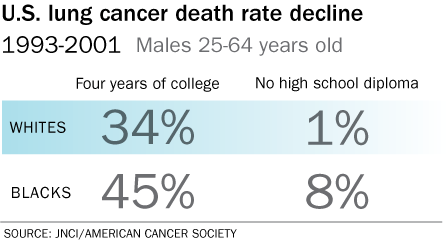Cancer and college
Highly educated people dodge cancer better than high school dropouts
Thanks to better screening, prevention and treatment, death rates from cancer in the United States have declined steadily in recent decades. But a new study finds that while college graduates have benefited from this trend, people who didn’t finish high school have lagged behind and even missed out on some of these gains.

Much of the discrepancy stems from differences between the groups in taking preventive measures such as quitting smoking or using cancer screening options, says study coauthor Ahmedin Jemal, an epidemiologist at the American Cancer Society in Atlanta.
But a lot can also be traced to the fact that 47 million people in the United States are uninsured, he says. Education levels closely track with socioeconomic levels, and that means access to good health care and insurance coverage to pay for it, he says.
Jemal and his colleagues analyzed data collected by the NationalCenter for Health Statistics, part of the Centers for Disease Control and Prevention, from death certificates filed in 37 states and the District of Columbia. The research team concentrated on people ages 25 to 64 who had died from 1993 to 2001, calculating mortality rates during that time period for the four most common cancers—lung, colorectal, breast and prostate. The sampling of the non-Hispanic population included more than 500,000 deaths.
The researchers report in the July 16 Journal of the National Cancer Institute that while some death rates fell dramatically between these time posts, significant differences emerged across the board based on educational background. For example, the death rate from lung cancer over that span dropped by 5 percent annually in white men and 7 percent annually in black men who had been through college. But among men who had dropped out of high school, the lung cancer death rate remained largely unchanged in whites and dropped less than 1 percent a year in blacks.
Meanwhile, colorectal cancer fell significantly over that time in men and women, black and white, who had gone to college, but not in their counterparts who hadn’t finished high school.
Other research shows that roughly 50 percent or more of highly educated people get regular colonoscopies that can catch and remove colorectal cancer early, but that among poorly educated people the number is closer to 30 percent, Jemal says. “The difference by education is mind-boggling,” he says.
Among whites, breast cancer death rates declined broadly, and women with more education showed greater decreases. But among black women, only those with four years of college showed clear declines.
In men, prostate cancer deaths showed a strong education-related decline among white men, but less of a decline for black men.
Much of the effect seen in this study could reflect access to health care, says health economist Cathy Bradley of VirginiaCommonwealthUniversity in Richmond. But another factor could play an equally important role, she says.
“I think education is a marker for something else,” she says. “People who invest in an education also invest in their health and place a higher value on the future than on the present.” Hypothetically, this prioritizing would be reflected in lifestyle, and these people might even seek out jobs with better insurance plans.
In contrast, people who don’t invest in the future, as in a high school diploma or a college degree, may place more value on the present, she says. Because cancer is an invisible disease whose causes have little immediate impact, these people may concentrate on satisfying immediate needs and show less regard for future risks.







